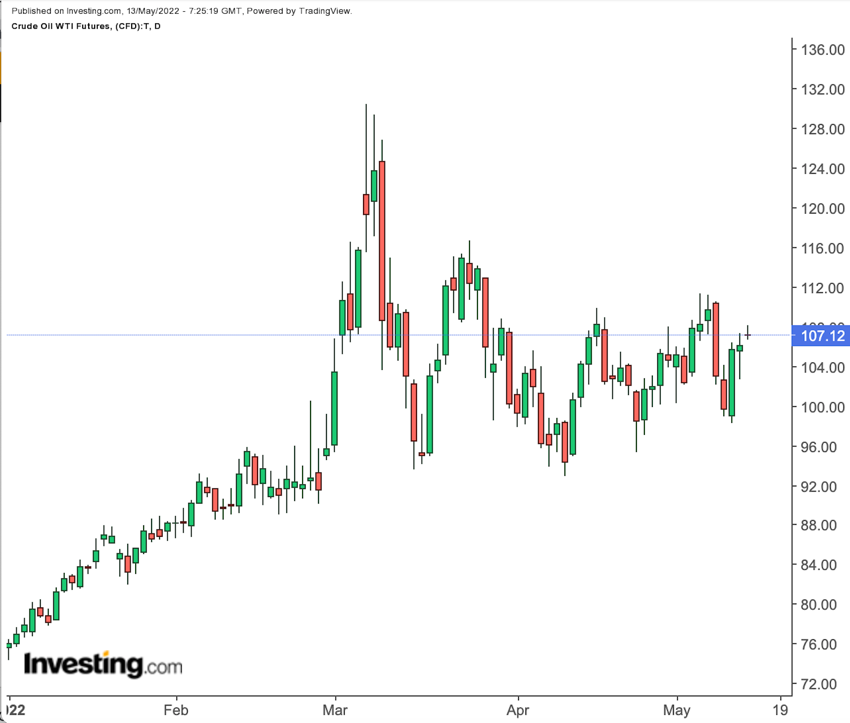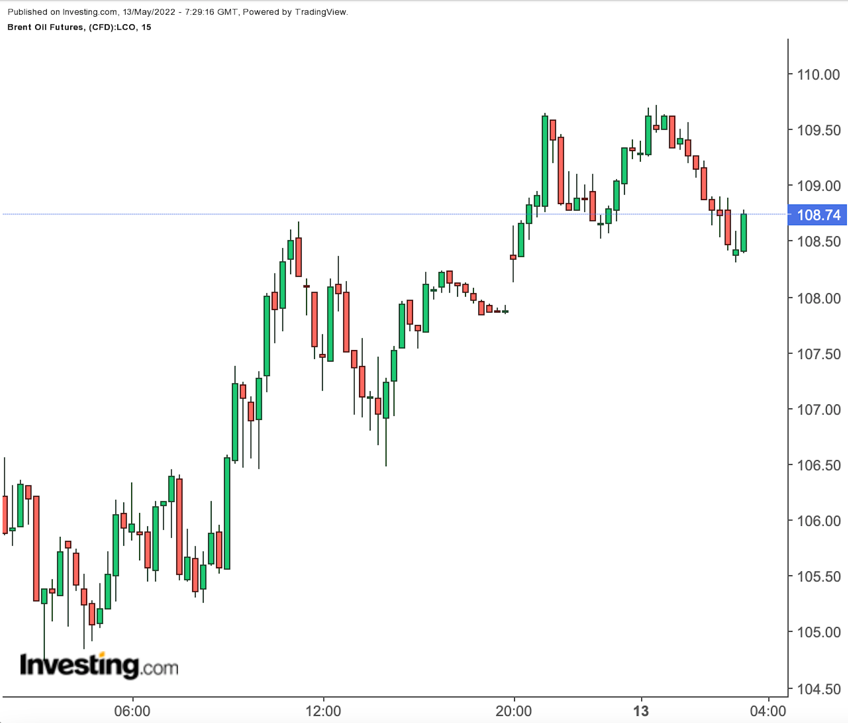Record-high fuel prices are testing the mettle of US consumers. How much further can they go, before the bubble pricks, is what oil bulls are trying to find out.
As crude markets were set to finish a ninth straight week boxed in a range of under $115 a barrel, one thing was becoming clear: It’s going to take a full EU ban of Russian oil or another supply disruption story of that parallel to bring the market back to or beyond the Ukraine-invasion peak of almost $140.
Barring that, for crude to set new highs for the year, demand has to be unbridled this summer, with everyone driving, flying, and taking cruise holidays as planned without worry about the economy or new COVID outbreaks, particularly in China.
The reality though is that the European embargo on Russian oil is being held up now by a Hungary panicking about its own energy security.
In the United States, it’s not just inflation at 40-year highs that’s choking the consumer. The Federal Reserve is unflinching in its bid to impose some of its severest rate hikes ever to bring prices back under control. That promises further pain over the coming months. Wall Street is, meanwhile, on the cusp of a bear market, and mortgage rates are soaring too, threatening to bust this year’s record home-ownership.
Weighing On Oil: China COVID, Record US Fuel Prices
And China is barely out of the woods with the response to its COVID 2.0 outbreak, signaling that Beijing might soon undergo the sort of prohibitive long-running lockdowns imposed on Shanghai. Data on oil demand in the world’s largest importer of the commodity remains gray: Crude imports by China in the first four months of 2022 fell 4.8% from a year ago, although April imports alone were up nearly 7%.
Talk of demand destruction for oil gained momentum this week as gasoline hit record highs of $4.50 per gallon at some US pumps while diesel rose to eye-watering levels of above $6. After a two-day slide of almost 10%, oil longs aggressively bought crude on the dips, halving the market’s loss by Wednesday.
But the laser focus of macro investors on the Fed’s tightening action—and whether that could ultimately do the economy in—returned to haunt the oil market on Thursday. After spending the first half of the session in the negative and the second half higher, the two crude benchmarks settled the day mixed and little changed.
By Friday, at the time of writing, Brent crude, the global benchmark for oil, was up more than 1% on the day, hovering at under $110 a barrel. West Texas Intermediate (WTI) the benchmark for US crude, was up similarly, trading below $108. To end the week in the positive, they still needed to rise about 3% or more each.

More important than that perhaps was the gnawing feeling that crude longs could no longer summarily dismiss the negative impact of the inflation-recession talk—despite the US government reporting healthy fuel demand numbers each week based on gasoline and distillate inventory draws.
“Oil prices remain a volatile trade as the crude demand outlook grows more uncertain,” said Ed Moya, analyst at online trading platform OANDA.
“Inflation remains uncomfortably high and has accelerated global growth concerns. The risk-off tone on Wall Street is leading to a much stronger US dollar which is weighing on oil prices.”
Indeed, the International Energy Agency cautioned on Thursday that soaring pump prices and slowing economic growth are expected to significantly curb the demand recovery through the remainder of the year and into 2023.
And while many energy traders remain fixated over the EU’s potential ban on Russian crude, fear of disruptions from that seems to be losing momentum, said Moya.
“In this market environment, oil will struggle if China moves forward with city-wide lockdowns,” he said, adding that longs in crude will have to hope that summer US road trips and flights and cruises hold up the demand picture.
Economists fear that the US economy, finally on the path to resilience after the damage wrought by the two-year-long coronavirus pandemic, could head for negative growth again from the Fed’s rate hikes.
“Concerns over the economy are legitimate and real,” said John Kilduff, partner at New York energy hedge fund Again Capital.
“The cost of diesel represents the real economy. At more than $6 a gallon, that’s cutting into the bottom line of companies and we could be on the precipice of a major demand destruction in diesel.”
Adds Kilduff:
“Already, there are fewer Amazon trucks on the road making deliveries, while there has been a huge uptick in credit-card spending, showing the consumer is getting rapidly tapped out. It’s all coming home to roost for those long-oil.”
So far, little of these seem to worry oil bulls as WTI remains up 43% on the year, versus a gain of more than 40% for Brent.
“After a significant rally above some key moving averages and trend lines, oil prices have pulled back a bit because of concerns about global economic growth and cryptocurrencies,” said Phil Flynn, analyst at Chicago’s PRICE Futures Group and one of the more vocal oil bulls on the market.
“The reality is that we believe the market will become more focused on the tightness of supply than on the destruction of demand.”
Those long-crude also have their backs covered by OPEC+. The global alliance of oil exporters has managed to push crude prices up from their lows whenever it meets each month, by offering meager production hikes well above the market’s needs.
'Frenemies' And The Fed
Even so, Saudi Arabia, which leads the original 13-member Organization of the Petroleum Exporting Countries that dominates OPEC+, abruptly slashed this week's official selling prices for its oil cargoes to be loaded in June for shipment to Asia, Europe, and the Mediterranean.
Saudi Aramco (TADAWUL:2222), the state oil company of Saudi Arabia, typically does not give reasons for raising or dropping the selling prices of its crude. But its latest pricing down came amid reports of Russia aggressively discounting its oil, sold in the black market due to sanctions by the West. Russia leads the remaining 10 countries in OPEC+ that do not directly come under Saudi Arabia.
“The Saudis may be Russia’s best of friends within OPEC+ in helping to thumb down the West’s sanctions against Moscow,” said Kilduff.
“But when they deeply discount their oil in the black market, the Russians are acting as ‘frenemies’ of Saudi Arabia, whose main aim now is to keep a barrel at above $100.”
Traders like Kilduff are also concerned over how far the Fed will go with rate hikes.
The central bank has so far approved a 25-basis, or quarter-point, hike in March and 50 basis, or half point, increase in May. Money market traders have priced in a 83% possibility of a 75-basis, or three-quarter, point hike in June. Fed Chairman Jerome Powell, in an interview published Thursday, all but vehemently denied that there will be such a larger increase for next month, citing his preference to continue with 50-bps hikes for two more months at least.
But Powell also said something worrying—achieving a soft landing for the US economy from the Fed’s rate hikes will depend on factors beyond the central bank’s control. Slowing wage growth—a key component of inflation now—won’t be easy, he said.
“It’s quite challenging to accomplish that right now, for a couple of reasons. One is just that unemployment is very, very low, the labor market’s extremely tight, and inflation is very high.”
After contracting 3.5% in 2020 from disruptions forced by the coronavirus pandemic, the US economy expanded by 5.7% in 2021, growing at its fastest pace since 1982.
But inflation has grown just as fast as the economy, or maybe a tad quicker. The Personal Consumption Expenditure Index, an inflation indicator closely followed by the Fed, rose by 5.8% in the year to December and 6.6% in the 12 months to March. Both readings reflected the fastest growth since the 1980s. The Consumer Price Index and the Producer Price Index, two other key gauges for inflation, rose 8.3% and 11%, respectively, in the year to April.
The Fed’s own tolerance for inflation is just 2% per year. Powell has indicated that a total of seven rate hikes—the maximum allowable under the central bank’s calendar of meetings this year—were on slot for 2022. More rate adjustments could follow in 2023 until a return to the 2% inflation target is achieved, he said.
“My fear is that the Fed might overdo it,” said Kilduff.
“With the COVID-related physical stimulus already abandoned by the federal government, there will be a lot less liquidity in the system in the coming months. If the Fed brings an ax to the system via excessive rate hikes, we might end up chopping up entire arteries of the economy.”
Disclaimer: Barani Krishnan uses a range of views outside his own to bring diversity to his analysis of any market. For neutrality, he sometimes presents contrarian views and market variables. He does not hold positions in the commodities and securities he writes about.
